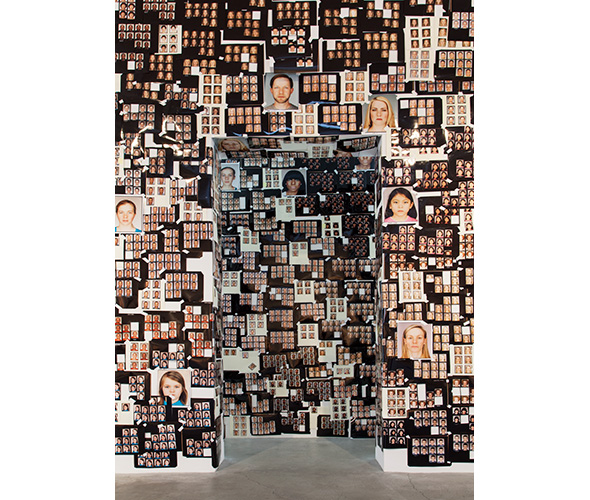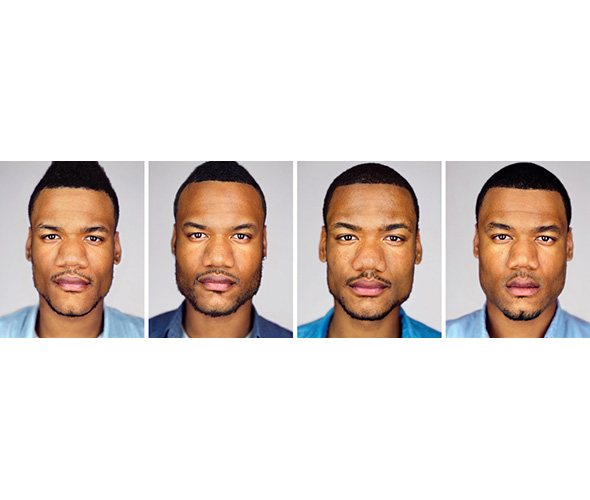In January, 2012, National Geographic ran a piece called “TWINS: Alike But Not Alike,” that used the August, 2011 Twins Days Festival (held annually in Twinsburg, Ohio) as a launching pad for a discussion of the latest scientific advances in twin studies, including both nature versus nurture issues and the burgeoning developmental field of epigenetics. As part of their coverage, they published a series of large format portraits of pairs of identical twins, complex and powerful presences, taken by photographer Martin Schoeller. That work has now expanded into a massive and beautifully realized project dubbed “Identical: Portraits of Twins” and recently on view at ACE Gallery Beverly Hills.
Schoeller’s award-winning work, both as an art photographer and on assignment for National Geographic and for any number of other prestigious publications, is not hard to place into a general photographic and art-historical context. We can see echoes of August Sander (Schoeller was born and raised in Germany), Annie Leibowitz (with whom he worked as an assistant from 1993 to 1996), Richard Avedon, and, in “Identical” especially, painters like Chuck Close and (reaching a bit further back into history) the 15th-century Netherlandish master Jan van Eyck. Even when his subjects are “eccentric” (as in his series of female body builders) or controversial (he was responsible for the nursing mother and son cover of Time Magazine’s May 21, 2012 issue featuring the lead story “Are You Mom Enough?” that generated considerable negative blow-back) his style is austere, minimal, an as-if record of “just the [pictorial] facts.”
This same basic approach is apparent in the pairs of portraits that comprise “Identical.” (There are two sets of triplets and three sets of quads as well.) The compositions are simple frontal headshots filling the entire frame. Backgrounds are neutral, varying across a narrow band of shades and running the gamut from light to dark without ever quite reaching the finality of black. The sitters are seemingly posed so as to betray as little as possible of an interior life. The intention seems to be that they appear affectless. The eyes that supposedly window the soul instead reflect highlights, brilliantly set up to be virtually identical in every shot, that seem to deny rather than admit access to any imagined interiority. Yet for all of that, the sense of vivacity, of life vibrating within the constraints of pose and format is amazing. The portraits index living presences in a way that is profound, resonant, powerful, and strangely intimate. The best of them, for example the pair Marta and Emma Croll-Baehre, seem almost magically present, not even lacking the voice that (in a trope dating back to the Renaissance) is supposed to separate the living presence of the sitter from the from the “contrafact” or counterfeit of the portrait.
Certainly size is a factor here. The portrait pairs come in two sizes, the smaller being 35″ x 43″. In a sense, this more-than-monumental scale enforces the presence of the sitters, which is made the more insistent by the fact of their apparent reduplication. Here, however, the experience becomes more interesting, more complex, and more compelling. In looking back and forth between, say, Emma and Marta, it soon becomes apparent that while the descriptive term “identical” may apply to the DNA from which the twins have inexorably developed; the actual physical course of that development has been influenced in so many ways by the chances of biochemistry and epigenetics (the influence of non-genetic factors on the expression of genetic traits) that the sisters seem both alike (like “two peas in a pod” or two coins struck from a single die) and yet different in a thousand subtle and not so subtle ways. And it is in this play of difference within apparent identity that, again almost as if by magic, those faces become suddenly alive with individuality, betraying affect and emotion and psychological depth in a scintillating pattern of differences that can seem almost miraculous.
The manner in which Schoeller achieves these effects involves a meticulous process of selection from (sometimes) hundreds of shots in the same basic format with relentlessly small and systematic changes in lighting, exposure, etc.,—as we can see from the enormous collection of contact sheets and working prints that have been taped up to the gallery’s walls and ceilings to provide an entrance to the selection of large-scale images that constitute the show proper. (I would have preferred a more systematic presentation of this material, which might have coalesced into a marvelous minimalist or serial presentation.)
Although the juxtaposition of the Croll-Bahere twins seems to me to set the basic pattern for approaching the pairs of twinned portraits, always remembering that every pair (Bethany and Amanda Widerka, Keisher and Teisher McLeod, or whoever) provides an almost endless set of variations on the basic model, there are still some interesting particular cases. The quadruplets Keith, Victor, Jason, and Kevin Furtick, for example, push this set of relationships more-or-less to its limit; or perhaps I should say that the viewing strategy that worked so well for me with Emma and Marta was strained by the quads, stretched almost to breaking point by the multiplication of criss-crossed similarities and differences. Quite a different kind of jolt is provided by Aidan Key (born Bonnie Bowers) and Brenda Bowers, where the fact that the transexual twin still reads as uncannily “identical” with his sister makes a viewer revisit the show’s basic premises from an entirely different perspective.
Uncanny in quite a different way are the brothers Larry and David Demonet (born 1940). Among the oldest pair of sitters in the entire series, and the oldest actually presented in the show, their visages are eerily non-photographic in appearance. Perhaps it’s the very restricted color range, bleached-out snowy whites with touches of carmine and ice-water blue; perhaps it’s the stubble on their faces; for whatever reason(s) my first impression of them was of paintings rather than photographs, Close initially because of the scale and the format, and then van Eyck because of the meticulous detail. And although a second look was enough to return them to the world of the photograph, that first impression remained as a ghostly overlay or shadowy background to my perception, something that made Demonet twins unique, and especially present, as though we held in common a private little joke.
Finally, one must account at least briefly for the gigantic image that one faces across the length of the gallery immediately upon entering the main exhibition space, which comprises two half-faces, belonging to the innocently elegant Katie and Sarah Parks. The dual image has a curiously discontinuous effect, despite the fact that of all the sitters represented in the exhibition, Katie/Sarah’s vivacious presence seems most organically and paradoxically connected to a lithe, athletic, and unseen body. I suspect that both the curiously disjunctive look of the composite head, as well as (perhaps) the equally curious sense of a “phantom” body below derives from the fact that Katie and Sarah are “mirror-image” twins. The occurrence of mirror-image twinning results from an especially late splitting of the fertilized egg (at nine to 11 days, almost at the point past which twins will be conjoined) and mirror-image twins, exactly as the designation implies, relate to each other in many ways (right- and left-handedness for example) as identical yet mirror-image reversals. Thus, the face we see in the Katie/Sarah composite is like a right-right or a left-left construction, a visual anomaly easier to miss (although I think still apparent) when the two twins are viewed in full-face side by side.
In any case, “Identical” was in many ways a marvelous show: an endlessly brilliant play of similarity and difference, a celebration of identity in both its rather opposite senses, and a chance to feel oneself in the presence of some wonderfully alive and vivid personalities, whose apparent lack of affect in fact simply marked a being-at-ease both with being oneself and with being the rhyme or echo or even the mirror-image of a distinct yet “identical” Other.
All images courtesy ACE Gallery
Martin Schoeller: Identical: Portraits of Twins at ACE Gallery Beverly Hills ended June 30, 2013. For more info: acegallery.net








